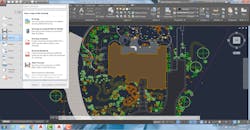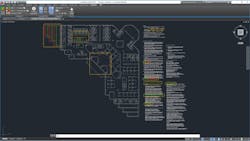AutoCAD Adapts and Evolves to Fit More Skilled and Agile Workforce
Marcus O’Brien, the current product manager for the entire AutoCAD family for Autodesk, started out as a mechanical engineering intern 16 years ago in Limerick, Ireland. He merely produced engineering drawings with the ubiquitous modeling program, not the whole thing. Much has changed for both O’Brien and engineers since then. They are asked to do more: more complicated, more systems, more quickly.
“I was purely focused on HVAC and plumbing,” he says of his early years. “Over time as I grew in my career, I had to learn more about electrical systems, generators, control circuity, high and low voltage systems.”
This was crucial as an engineering consultant for data center design.
“Every system must work together in harmony,” he explains, having to figure the HVAC system controlling “unbelievable tolerance in temperature and humidity” into the equation with rows of heat-generating computer servers and their cooling systems.
As plants and factories get smarter, with more electrical overlapping with the mechanical considerations, the 35-year-old AutoCAD has undergone a similar “continuous evolution.” In 2018, Statista says IIoT devices reached 440.8 million worldwide, an increase of 21% over 2017. That will seem modest in the coming decade.
The recently launched AutoCAD 2019 facilitates the highest level of inter-disciplinary design by making available all seven specialized tool sets for all subscribers. The formerly individualized toolsets are: architecture, mechanical, electrical, MEP, Plant 3D, Map 3D, and raster design. This creates a library of more than 750,000 intelligent objects, styles, parts, features, and symbols. Subscriptions start at $195/month and $1,575/year.
“AutoCAD 2019 now includes specific tools for manufacturing, from small screws to entire milling machines,” O’Brien says. “Some of the more commonly used tools our manufacturing customers use include Power Dimensioning, Standard Parts and Features and our Parts list. We see customers designing automotive parts, large turbines and generators, ship building as well as mechanical parts like pumps, valves etc."
Along with speaking with customers and taking their feedback into account, Autodesk conducted a test study in 2015 to find out how much time could be saved by using the specialized toolset over the “vanilla” AutoCAD to add balloons and create a corresponding parts list. The result was more than 40% increased efficiency.
“Using AutoCAD it takes 12 commands, but because there are specialized features for this in the mechanical toolset, it can be done in five commands,” O’Brien says. “In terms of time saved on this rudimentary task, this adds significant efficiency to AutoCAD customers. Now imagine those efficiency gains across the entire portfolio of specialized toolsets.”
He says ultimately the update will break down siloes and provide the most value for customers.
“We are going to see an evolution of people using these specialized tools together in new ways,” O’Brien says. One example he gives is a mechanical engineer now being able to change electrical components on a proposal, because they have the tools to do so.
That’s something that could be commonplace for future engineers who will have artificial intelligence and predictive analytics assisting them in building data-driven manufacturing environments.
“Graduates today are going to have to be absolutely excellent in understanding data,” says the product manager, citing advances in IoT, sharing economies, and overall collaboration. Unlike when he started, O’Brien says the upcoming generation will need to be fully fluent in mechanical, electrical, pneumatic, and hydraulic engineering.
“You’re no longer going to be able to get away with being a purely mechanical engineer. The specialization is going to continue, like being a robotics person, but you’ll be a robotics specialist, not a mechanic.”
New browser-based AutoCAD web and mobile apps, also expand accessibility to the modern, agile worker. Even if signing into their Autodesk account via a mobile device, they can access Trusted DWG files, core 2D drafting and editing tools 24/7. This means you can sneak one last glance at prototype design at the airport, or make running changes on your tablet at the jobsite. Any changes are saved back at the local network drive.
“We want to enable our customers to work anytime, anywhere,” O’Brien says.
Evolving doesn’t mean abandoning the traits that help you survive, and AutoCAD has not forgotten has helped it thrive for more than three decades.
The new version has streamlined it 2D graphics so any operation that requires redrawing or regenerating the model, such as zooming or changing layer properties, can now be done up to twice as fast.
“There’s tremendous market for 3D design, but 2D is not going anywhere,” O’Brien says. “For early concept validation, communicating ideas, it’s as relevant if not more relevant as it has been in the past.”
About the Author
John Hitch
Editor, Fleet Maintenance
John Hitch, based out of Cleveland, Ohio, is the editor of Fleet Maintenance, a B2B magazine that addresses the service needs for all commercial vehicle makes and models (Classes 1-8), ranging from shop management strategies to the latest tools to enhance uptime.
He previously wrote about equipment and fleet operations and management for FleetOwner, and prior to that, manufacturing and advanced technology for IndustryWeek and New Equipment Digest. He is an award-winning journalist and former sonar technician aboard a nuclear-powered submarine where he served honorably aboard the fast-attack submarine USS Oklahoma City (SSN-723).


